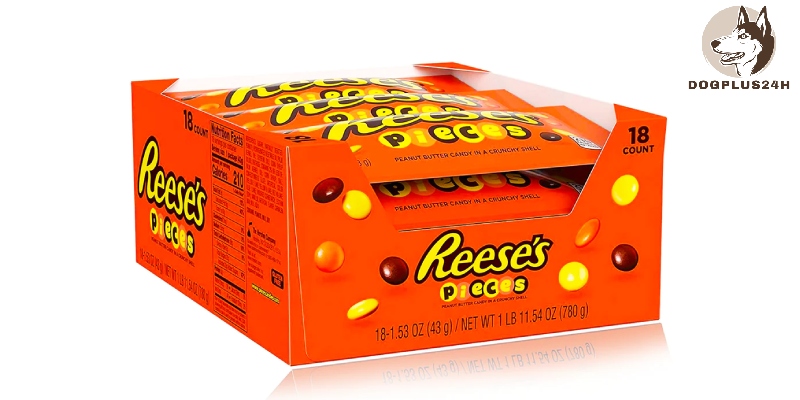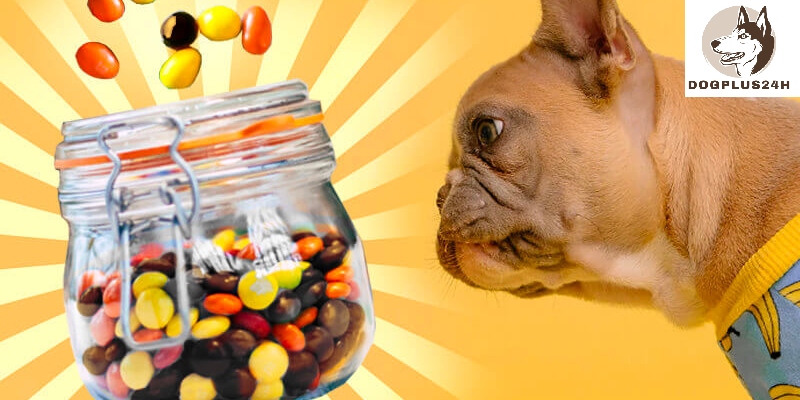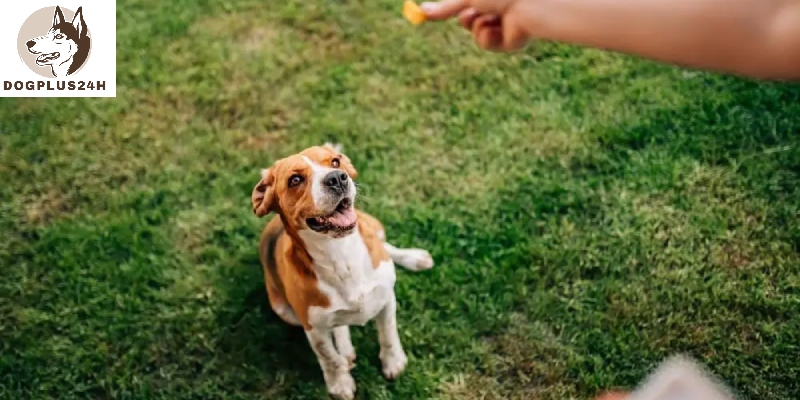Can dogs eat Reese’s pieces? It is dependent on how much candy your dog receives and how frequently it receives it. A few pieces will not hurt your dog, but you should not offer Reese’s pieces to your dog on a regular basis. Because they can pose major problems in the long run. In this post, we will help you answer all about Reese’s Pieces
What are Reese’s pieces?
Reese’s Pieces, a beloved American candy, made its debut on the US market in September 1978. Reese’s Pieces weren’t released to the Canadian market until later in 1980.
If you’re a big fan of the 1982 film E.T. the Extra-Terrestrial, you probably already know that this candy appeared in it. Following the debut of this film, Reese’s Pieces gained popularity.
Reese’s Peanut Butter Cups gave rise to Reese’s Pieces. These two candies are comparable in that their primary ingredient is peanut butter. Reese’s Pieces are different since they don’t include any chocolate.
Instead, it comes in a flat circular shape and is encased in a variety of candy shell colors. You may find them in three colors: orange, yellow, and brown, and they are about the size of a pumpkin seed.
What exactly are the components of these Reese’s Pieces, though? Let’s start now.
What are the main ingredients in Reese’s pieces?
The main ingredients of Reese’s Pieces are:
- Sugar
- Corn Syrup
- Vegetable Oil
- Peanuts
- Milk
- Salt
- Artificial Colors
- Artificial Flavors
- Soy Lecithin
- Vanilla
- Resinous Glaze
- Cornstarch
- Carnauba Wax

Some of these substances, such as peanuts or soy, may cause allergies in dogs. Before you give your dog Reese’s Pieces, consider their physical preferences. Can dogs eat Reese’s pieces? Continue reading the article to get the answer.
Can dogs eat Reese’s pieces?
Can dogs eat Reese’s pieces? Reese’s Pieces should not be given to your pets since they contain substances that are toxic to dogs. However, if you’re only serving a few Reese’s Pieces as a rare treat, that should be acceptable.
This is due to the high sugar content of Reese’s Pieces, which can promote obesity, dental problems, and diabetes in dogs. Another key element that may be dangerous to dogs with peanut allergies is peanuts.
Artificial flavors and colors, as well as salt and milk, can be problematic for our canine companions, as they can cause gastrointestinal upset or aggravate food sensitivities.
Although Reese’s Pieces are not dangerous to dogs and it may appear that giving them a few pieces is acceptable, it would be preferable to provide nutritious, canine-friendly alternatives instead.
If you want to give your pet something sweet but don’t want to risk their health or safety, avoid giving them any candies or treats that contain xylitol.
What are the dangers of dogs eating Reese’s pieces?
When your dog consumes an entire package of Reese’s Pieces, the calories, fat, and sugar they absorb will have immediate and long-term consequences. Below are detailed instructions.
Dangers of fat
Fat is necessary as a macronutrient in a dog’s diet since it helps to maintain healthy eyes, skin, and coat as well as ensuring that the brain functions normally. Experts recommend that a 33-pound dog consume 14 grams of fat each day.
Excessive fat consumption, on the other hand, promotes the formation of fatty tissue and, as a result, undesired weight gain. The fatty tissue will exert severe strain on internal organs, joints, and bones, thereby impairing physical processes.

Maintaining a high fat percentage for an extended length of time might result in serious issues such as diabetes, obesity, and heart disease. When your dog consumes a considerable amount of fatty food in a short period of time, he is more likely to develop abrupt acute pancreatitis.
Acute pancreatitis is a disorder in which the pancreas gets inflamed rapidly as a result of a high fat diet, resulting in internal pancreatic destruction. Pancreatitis symptoms include vomiting, stomach pain, fever, tiredness, and a crooked back.
If treated promptly, most dogs recover from pancreatitis. However, the situation can swiftly deteriorate and become life-threatening.
Dangers of sugar
Consuming Reese’s Pieces might cause a variety of urgent gastrointestinal problems. Diarrhea and vomiting are two common gastrointestinal disorders related to sugar consumption. These effects occur because extra sugar attracts water into the intestines. This can lead to dehydration and other intestinal problems.
Sugar consumption, like it does in humans, causes weight gain and teeth decay in dogs. Giving sugary meals to your dog on a regular basis and allowing it to retain a high fat content can contribute to the development of metabolic problems, diabetes, and obesity.
A poor diet and an unhealthy routine will cause your dog’s body composition to shift from predominantly muscle to primarily fat. This will reduce motivation to walk around and exercise.
The lack of exercise will cause it to gain weight, increasing the probability that your dog will develop diabetes. When a dog becomes diabetic, his or her body is no longer able to create enough insulin to convert food for energy.
What do you do if your dog ate a Reese’s Pieces?
Can dogs eat Reese’s pieces? The answer is no. What do you if your dog ate Reese’s pieces? If you suspect your dog has eaten a few or too many Reese’s Pieces, contact your veterinarian right away to discuss how to manage the matter. They will advise you on temporary measures you can take to help your dog feel better and prevent long-term damage.
Reese’s Pieces contain a lot of sugar, which might create major problems for your pet. So, after offering temporary first aid, take your pet to a veterinarian who will perform a thorough examination of the stomach to see if the digestive tract has been damaged.

If this is the case, they may require surgery to remove the afflicted sections of their digestive system. Even if there are no evidence of internal harm, your dog may experience stomach distress or diarrhea as a result of consuming too much sweets.
Your veterinarian will be able to determine the amount of sugar taken and whether it is creating symptoms in your pet such as vomiting or diarrhea.
How can I tell if my dog is allergic to Peanut Butter?
You’ll know straight immediately if your four-legged pal is allergic to peanut butter. Many dogs develop mild, moderate, or severe allergies to peanut butter fairly shortly after consuming it.
You will see the following symptoms of peanut butter allergy in dogs:
- Vomiting
- Sudden diarrhea
- Excessive licking of skin
- Excessive drooling
- Red or itchy skin
- Fast heartbeat
- Agitation
- Shortness of breath
Note that there are two types of peanut butter allergy in dogs:
- Reaction inside the body
- Skin allergy or atopic dermatitis
The most severe allergic responses in dogs might result in anaphylactic shock. Take your beloved pet to the vet right away. Your veterinarian will almost certainly administer adrenaline to your dog.
The good news is that treatments are usually effective, and your pets will recover completely. Your veterinarian may also recommend an EpiPen or allergy medicine in case this happens again.
If your dog ate Reese’s Pieces, should you induce them to vomit?
If your dog has eaten Reese’s Pieces, there is really no need to make them vomit. Only after they have ingested multiple servings or multiple packets at once may you need to induce vomiting. (If this has occurred, force your dog to vomit by administering 3% hydrogen peroxide at a dose of 1 teaspoon per 5 pounds of body weight.)
Most of the time, all you need to do is make sure your dog is drinking lots of water and, if necessary, fast it the rest of the day if it vomits or has diarrhea.
Technically speaking, eating a ton of Reese’s Pieces could cause pancreatitis since the dog wouldn’t be able to handle all the extra fat and sugar it was suddenly exposed to.
If such a situation arises and you see your dog hunched over in discomfort or seeming lethargic, be sure to call your veterinarian right away for advice.
How many Reese’s peanut butter cups can a dog eat without getting sick?
One Reese’s peanut butter cup is too many for a dog of any size, according to the majority of vets. Almost all veterinarians would advise against ever purposefully giving a dog Reese’s peanut butter cups or any other kind of chocolate.
A huge dog might be able to consume one without experiencing any stomach problems. Even doing that is bad for the dog and could lead to issues if done frequently.
A whole one might make a little dog ill, but it probably wouldn’t be fatal. Typically, milk chocolate is not potent enough to pose a major risk to one’s health. Even still, even one peanut butter cup might make a tiny dog rather ill.
We all care deeply for and wish the best for our dogs. We also desire their happiness. If your dog sees you eating Reese’s peanut butter cups, it could try to join you. They could offer you a sorrowful expression that compels you to comply with their demands.
But keep in mind that feeding any sort of chocolate to a dog is unhealthy. Giving chocolate to your dog is equivalent to poisoning it. The best you can hope for in that circumstance is that they will experience stomach pain and vomit the food they have consumed. Dog owners must make the best decision for their dogs as they are accountable for their animals. It’s never a good idea to give kids chocolate.
Reese’s peanut butter cups are popular among consumers, and your dog might like eating one as well. However, the dog is unaware that they are poisonous. It is the responsibility of people to prevent dogs from ingesting harmful substances.
Even if some goodies aren’t “good” for your dog, they don’t really hurt them. One example is bread or a few cookies. However, chocolate is undoubtedly harmful to your dog and will injure them to some extent.
How unwell your dog becomes depends on the size of the dog and the amount of chocolate consumed. Studies have revealed that prolonged exposure to theobromine, even in low doses with no symptoms, can weaken your dog’s heart muscles’ ability to pump blood.
That might eventually cause heart failure and reduce the lifespan of your pet. This is why giving even a large dog modest quantities of chocolate is a bad idea. Long-term heart problems may result from it, and it may be harmful in the short term.
In conclusion
Can dogs eat Reese’s pieces? If you give your dog a modest number of Reese’s Pieces, it will not kill him. However, due to the high sugar and fat content of Reese’s Pieces, you should not feed them to your puppy. It’s easy to swallow a whole bag at once, especially if you don’t keep a careful eye on your dog, and the results will be disastrous.


